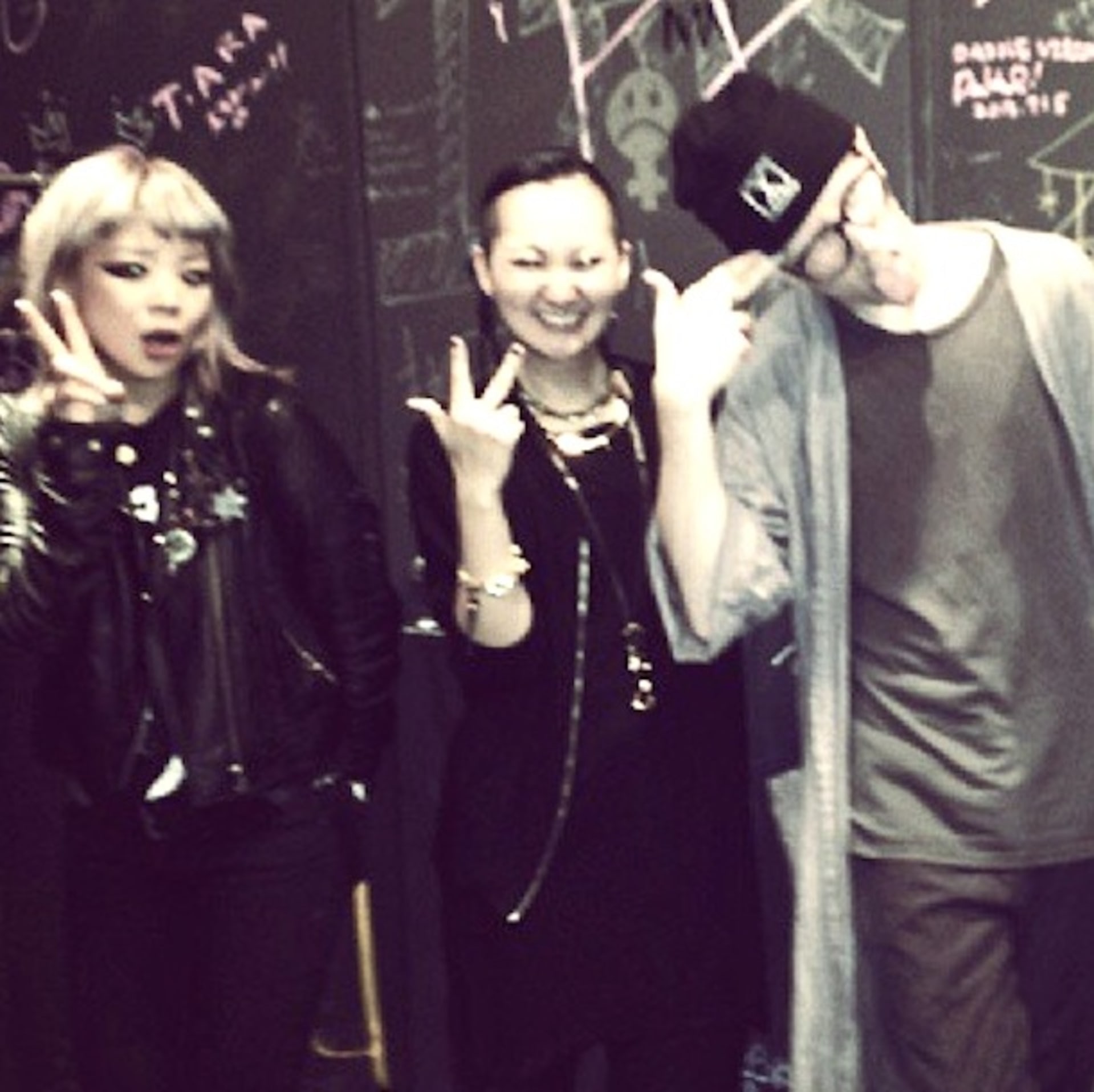
Dark Son Rising: BlackBlackGold’s Tour Diary of Japan
Above: BlackBlackGold (second from the left) and friends at Kyoto’s Chion-in.
For the uninitiated outsider, underground scenes anywhere can be daunting. Cultures all have different rules, and their accompanying sub-cultures are no different. Having been a traveling DJ for seven years, I can safely tell you that clubgoers in Leipzig, Germany and Bordeaux, France’s underground clubs will react very differently upon hearing similar sets, and learning how to respond to each can be a bit nerve-wracking—but that’s a type of fun in itself. Therefore, mentally applying the same rules I’ve learned in my current base of Berlin with that of Japan would be pretty silly. My recent tour there under my alias BlackBlackGold, and having to deal with an anti-dancing law straight out of Footloose, taught me that much. I traveled the streets of Tokyo with its beautiful fashion stores and even more beautiful Harajuku kids, visited the temples and matcha houses of Kyoto, and got to know the staff and clientele of one of the coolest shops in Osaka. The experience was probably one of my favorite things ever, really. I also discovered a lot of places that the first-time visitor should see. Beyond the typical Western view of over-the-top outfits, Blade Runner visuals, and imagined antics that would make Hanatarash blush, there lies the Real.
September 21st: RADD LOUNGE
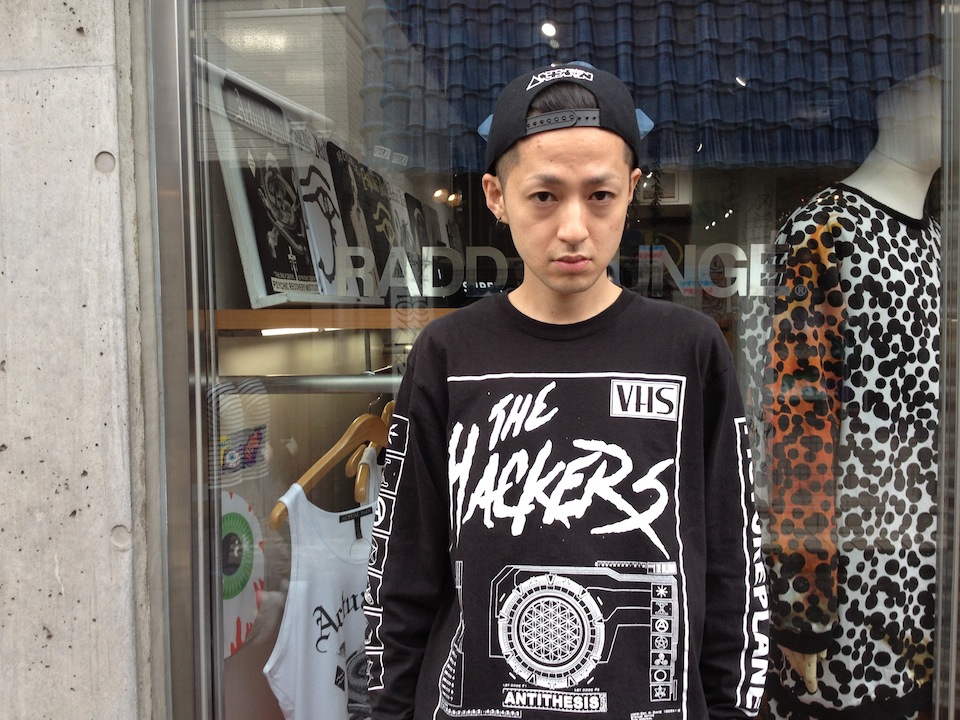
Above: RADD LOUNGE owner Akihiro Irikita, aka Iriki
Last night was the first time I DJ’ed in Japan, in a large studio at Tower Records, in front of a studio audience, and broadcast via a giant TV screen outside on the street. That was a bit mindblowing. I don’t think the mostly Japanese crowd got my jokes or the reason I jumped on to the table while I was playing (Japanese whiskey). Today it’s an in-store at RADD LOUNGE, a shop specializing in the weirder sides of Internet culture via the wearable and listenable. There’s excellent stuff from Actual Pain, Sixpack France, and Mishka sold alongside records from Fade To Mind and Lovepump United, and a large goa-delic alien drug-rug. Unfortunately, “Take me to your dealer,” doesn’t translate much here, as weed is about as illegal as heroin and treated with as much alarm. Unless you’re a heavy drinker or attracted to acidic cocaine, you might want to stock up on Minor Threat CDs. Iriki has owned RADD LOUNGE for a year and a half, during which time he’s had a number of in-store performers and customers that include oFF Love, Kelela, Total Freedom, Visionist, and Pictureplane. It’s all very hyper-now, maximum-reblog stuff, and is highly recommended.
September 22nd: SODOM
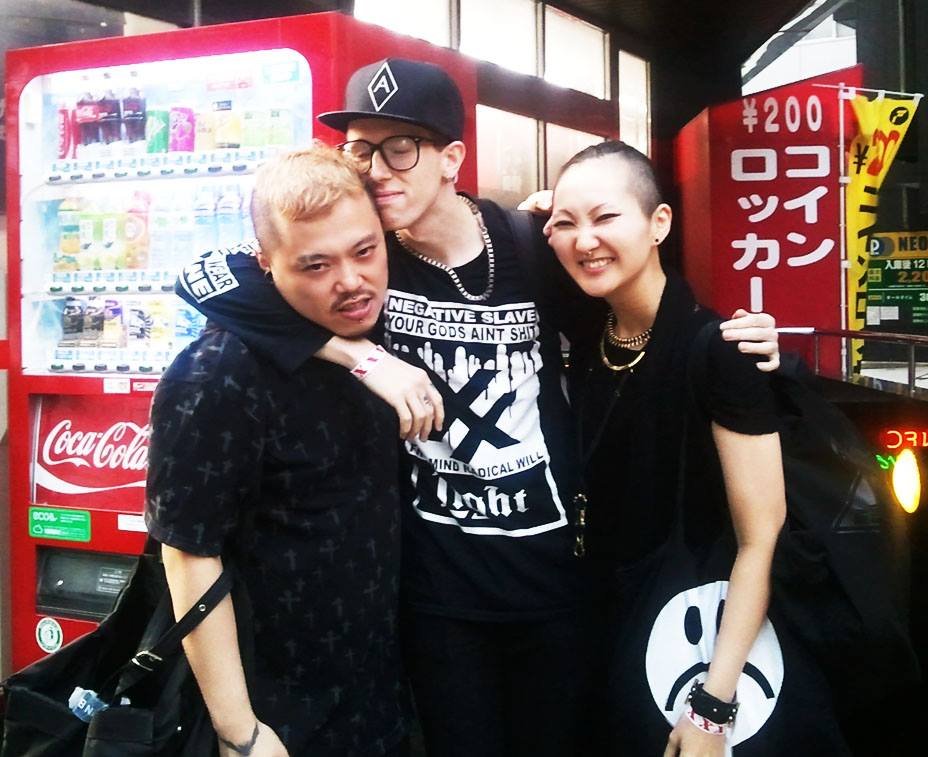
Above: Turning that frown upside-down with Taka Arakawa and Maiko Asami. Inset below, a police recruitment poster shows exactly what the cops are doing to nightlife in Japan.
I knew tonight was going to be fun as soon as I saw the stripper poles. SODOM, the dark queer party I was DJing that night, takes place in Shinjuku Ni-chōme—Tokyo’s gay hub. I was admittedly a bit nervous going in to this, since I know how gothy types tend to be about straying too far from genre safety-points and connecting the dots to, say, Death In June and Divoli S’vere. It went down extremely well, in fact, though it might have been because I started my set with a bar-straddling, karaoke-led version of 3 Teeth’s “Nihil“. Performing before and after my set were several bands, one of which included two topless, paint-covered women in lampshade hats named group A. I’m told that it’s very rare for women in Japan to be doing this sort of performance-based, intensely loud music; in fact, there are no other performers like them in the city, says Asami. I can’t help but wonder if it’s because group A have devoured all competitors. Though already exhausted from my own performance, their powerful teeth-scraping cacophony of synth-led noise punk kept me on the floor and soon had me soaked in a double layer of sweat and grime.
Promoter and fashion designer Maiko Asami‘s night is certainly a rarity. Before last year, there weren’t any parties in the city that catered to specifically new dark music, especially ones on a queer tip. Not content, she formed SODOM with her friend Taka Arakawa—the two of them, she says, make up most of Tokyo’s dark queer scene. Which is why she had doubts about starting a party specifically for it, but the response from both the underground and the fashion community has been strong. For their one year anniversary in June, they released a limited-edition sampler with minimal label Fabrika, and says she finds mixing lots of different genres together inspiring. That’s why she often books DJs from other scenes; less obvious choices who might not normally play such a party, but who cast something new onto the proceedings. “The scenes here are still very divided,” she told me. “Noise, techno, goth, or J-Pop are all the same: the bands play at nights that are one thing, their one-thing fans come to see them. It’s hard to find good queer DJs here, as well. Usually it’s just your basic electro/house/disco sort of thing.” She took a lot of inspiration from traveling to Berlin where, she feels, the sound is much more fluid and open. The lack of cutting-edge, Japanese language music blogs combined with the generally low level of English-speaking expertise (a running joke during my trip was, “This is a pen,” one of the first and seemingly only English phrases Japanese people are taught in school) means that there’s a surprisingly long time lapse in people finding out about music in Japan, as most of the information comes via magazine. By the time something is researched, written, edited, printed, shipped, and discovered, it’s months old.

The current political administration does its best to keep youth out of nightclubs as well, enforcing a law known as fueiho that allows them to break up parties without proper dancing licenses going past midnight or 1AM, and even arrest scofflaw club owners. There is, of course, a heavy moralistic stance behind the party crackdown. Now that the city will be hosting the 2020 Olympics, there’s more effort (and convenient excuse) than ever to stamp out the parts of the city that fall into what conservatives label “moralistic gray areas” that include the famous nightlife alleyway quarter Golden Gai, also rumored to be in the demolition path. Some —like the high-profile Let’s Dance, made up of club owners, DJs and other music figures, and Japan-based queer musician Terre Thaemlitz, whose Where Dancefloors Stand Still is a subtle jab at all the regulations — are trying to reclaim Tokyo’s nightlife, but meanwhile the draining effect on Tokyo’s party scene continues. “If these laws become more strict, it will be even harder for new music to be introduced to people.” says Asami. “Unfortunately, that’s an effect I see happening already. Osaka is even stricter than Tokyo; it’s almost impossible to have an event there. Unofficial DIY and squat events are out of the question; they would be broken up immediately. However, that doesn’t stop people who truly want to experience music with others from doing in-stores, gatherings… people will always find a way to have the things they love.”
BlackBlackGold DJ set recorded live at SODOM, September 22, 2013 in Tokyo
September 24th: Honey’s Dead
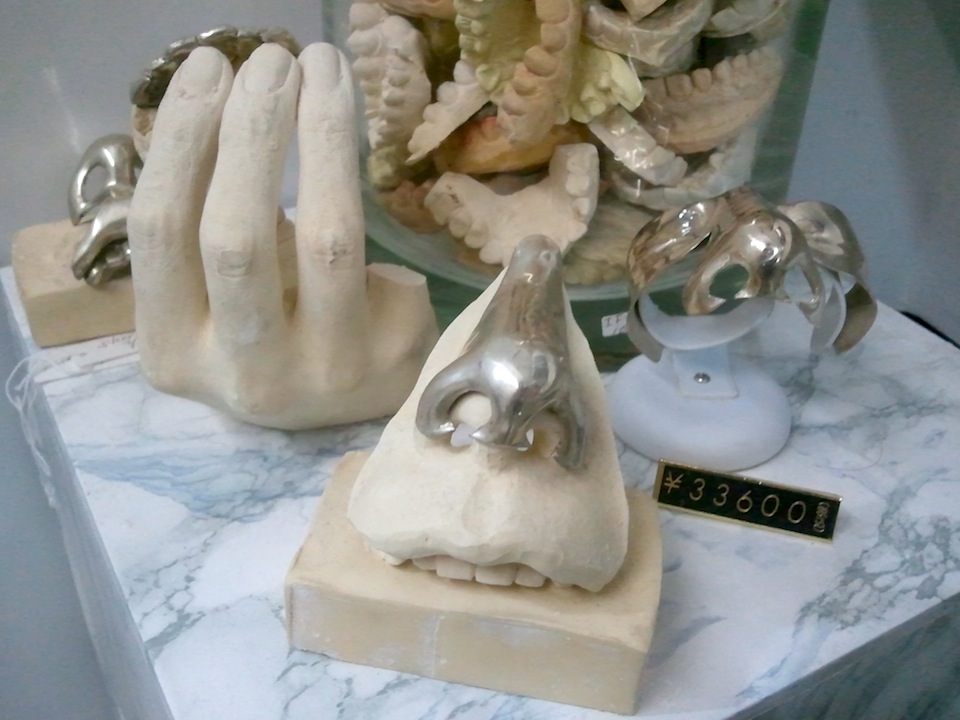
Above: Aside from a ball-pit changing room and a gallery of fetish-inspired art-as-clothing, Garter also carries Fangophilia, a selection of dentist-designed jewelry in case you fall apart.
I’ve now spent enough time wandering the streets and noisily inserting myself into random situations to have seen a decent portion of the amazing underground shops and venues that the city has to offer: DOG, where Tokyo style icon Hirari Ikeda holds court; Wut Berlin, whose beautiful designs by Tata Christiane will indeed elicit drawn out “wuuuuuuut”s; KITAKORE, the maze-inspired shop housing Garter/Secret DOG/ilil in the wonderfully decayed Kōenji district; Aoyama Tunnel, a small bar beneath a train station whose decor theme seems to be “Roman Hellraiser” and whose DJs spin a particularly inspired blend of cosmic disco strangeness. These are just a few of the places I’ve been to, and my spendin’ hands are becoming far too familiar for my wallet’s liking. Honey’s Dead is yet another place where I kind of want to just take everything off the wall and place it on my body, but I’m even more interested in meeting the owner, designer Hiro Sueyasu.
Tokyo youth culture tends to be based more around image than music; you’ll often see crowds of black-clad, dyed-hair kids repping spiked leather harnesses and creepers whose main point of musical interest begins with the letters K or J and ends with the word ‘pop’—an image-jacking that Hiro thinks has made underground fashion too mass-market. Still, he says, the idea of underground isn’t particularly necessary anymore. His new collection Suck It All is based around color-blocked designs combining Middle Eastern mysticism with black metal and skater references, and stands out in a local market already saturated with street-style obsessiveness (I’m fairly certain that Tokyo is the platform-shoe and sloganed beanie capital of the world) and means-nothing symbolism by putting his musical ethos behind the imagery to back it up. “I think that design in Tokyo is a bit like DJing,” says Hiro. “It’s about mixing lots of different ideas together to attract a larger crowd, while still trying to create something new from it, some new type of culture.” Like myself, Hiro also grew up on a combo diet of industrial post-punk and street-level hip-hop, and his gritty designs (particularly in his monochromatic sub-label Liber Oz) reflect that aesthetic in a way that stays true to his magickal influences while still being highly attractive to the sort of dude who considers Harajuku his main stomping ground. Which, apparently, means me as well.
September 27th: Osaka, Fragile
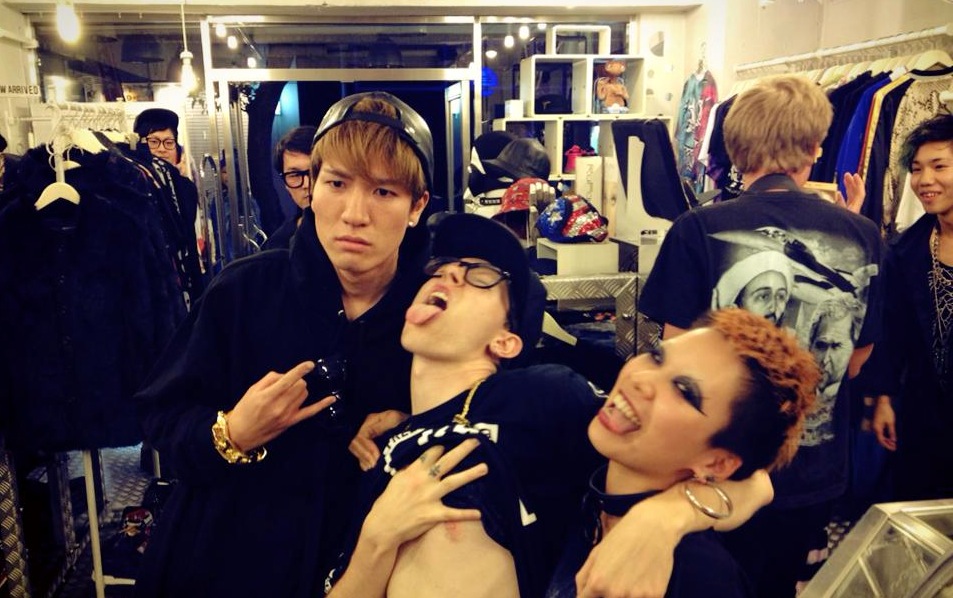
Above: Distressing de-stressing after a violently drunken instore DJ set at Fragile.
After a breathtaking tour of Kyoto’s temples heavily fueled by immense amounts of matcha-based food, I traveled on to Osaka for another instore DJ sesh at the excellent shop Fragile. My spiritual side sated, I switched over to my base instincts and spent the night out drinking and eating some fairly fucking delicious Canadian pizza with an old bandmate of mine. A magical encounter with an old-school Japanese biker (he was on a fat hog bumping Hammer’s “2 Legit 2 Quit” at maximum volume, we were walking in the middle of the street drunk, and the natural dance-off ensued) led to gorging on takoyaki—fried balls of octopus— like a rude hog myself. Which meant my face was covered with just the right amount of strange brown and white sauce to do the next thing on my schedule: a promotional photoshoot in expensive clothing. One noise music-inspired bomber from Komakino and high-end Swans tee (both of which I desperately wanted to steal) later and it was back to the street for more of Japan’s favorite sport: drinking! Because the party scene shuts down by necessity after midnight, you need to cram your debauchery into a much more condensed window. I was reeling by the time I played my set to the packed store, though not enough to fuck up more than once (hey, I’m a pro).
September 29: Tokyo, Big Love Records

Above: Masashi Naka’s store Big Love Records. If they served pizza, there’d be no reason to leave…
It’s my last day in this country. The previous evening I’d returned to Tokyo to DJ Chemical Monsters, another underground night with a focus more on cutting-edge hip-hop and UK bass. The other DJ sets were a pleasure to drop down to, Licaxxx‘s in particular had me doing some head-turning floorgrinds. It was interesting to see how the crowds overlapped; many attendees from my show at SODOM were there as well, and promoters from both parties expressed pleasure at the mingling of scenes and the potentiality for collaboration. I fondly recall one guy in a Supreme hat flipping his shit when I put a Bauhaus track over a Gucci Mane beat. So, despite already experiencing nostalgic loss for all the wonderful people I’d met and enjoyed in my too-brief time in Japan, I was feeling really good when I wandered into the best damn record store in Tokyo. Big Love is a small shop tucked away off of Harajuku St., and walking inside was a wash of familiar faces—records from musicians friends like Dandi Wind, Pictureplane, Butterclock, and Youth Code shared space with new albums from Lussuria and FKA Twigs as well as signed records from big-name visitors like Daft Punk, Chairlift, and Justice. Better still, they had an entire section for cassettes from new artists, and even better still, they had a bar in the middle of the aisles. Over an IPA and a TV showing the beautifully disturbing Oneohtrix Point Never video for “Still Life (Betamale)“, I had a chat with owner Masashi Naka that gave me another perspective on how youth music culture is developing (and devolving) in Tokyo right now.
“It’s difficult to be in the record store business,” explains Naka. “Japanese people don’t really want new music. The current economic situation means that music and fashion institutions, particularly the independent ones, are suffering. And, in my opinion, people here don’t use the Internet for music the way they do in America. Because of the language barrier there’s much less outside communication and less of a desire to dig for something. People here are much more satisfied with what’s on the surface world, especially young people. Modern Japanese music is usually not very deep, but it’s no effort for them to connect to.” As for how this affects the live music scene, Naka has seen a decline in attendance as well. Nights like SODOM, he says, are good examples of how this is starting to change a bit, and he cites the diversity of the crowds that go as being an integral part of shaking the apathy from Tokyo’s kids.
It’s something I spent a long time thinking about earlier today on my way to the airport (as I wasn’t able to speak much thanks to some farewell, powernoise-style Beyoncé karaoke with friends) and makes me hope that, as a promoter and DJ, I’ve been able to achieve something similar in my own events. Being able to inspire someone aurally and aesthetically is probably the most rewarding thing about this job. The kanji for the Japanese phrase “thank you” originally meant something like “it is difficult to exist”. For Japan’s underground music scene, this is certainly the case— which makes it all the more worthwhile, and all the more reason to give thanks for those who keep it alive. ありがとう ~
Special thanks to Caro Sundermeyer and Taka Arakawa for translation assistance.
Published October 17, 2013. Words by Daniel Jones.
